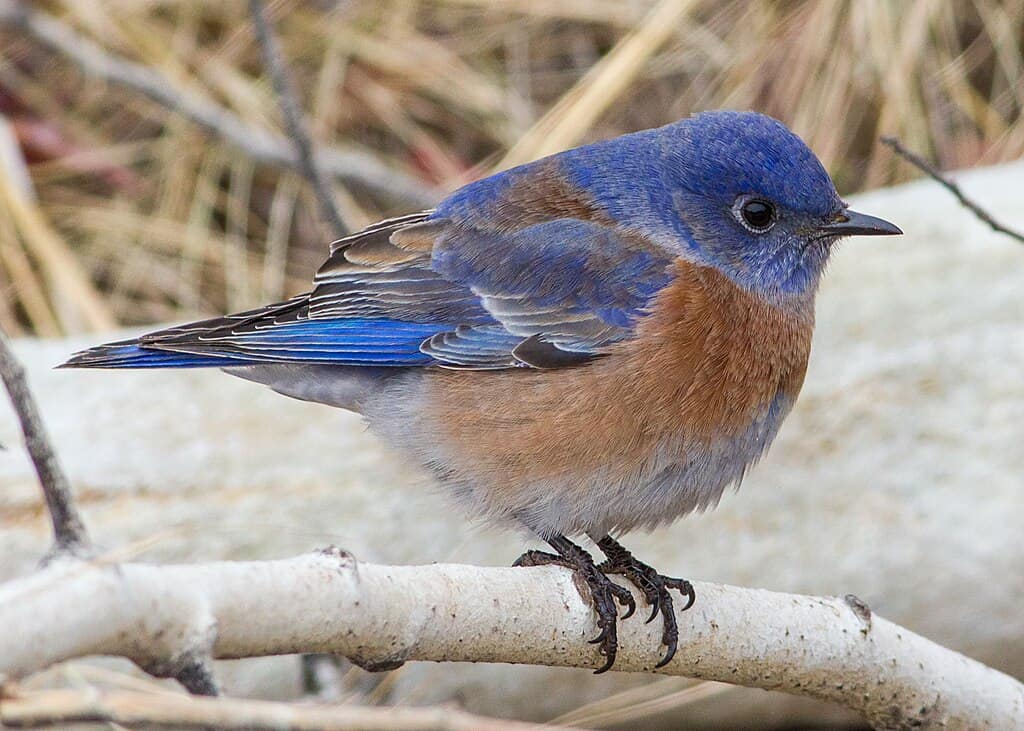Welcome to Animals and Wildlife in Delaware.
Are you curious to learn about animals and wildlife in Delaware? Delaware is the second-smallest state in the country, located between Pennsylvania and Maryland. All three states share the Delmarva Peninsula, and most of Delaware is on a coastal plain that is at sea level.
On the southern side of the state are rolling forests and hills and large farmland stretches, meaning there are lovely natural places for animals to make their habitat. It is a small state; unfortunately, agriculture, development, and industrialization have destroyed some of the animal’s natural habitat, the wetlands – only about 25% remains today.
Fortunately, steps have been taken to preserve the remaining wetlands.
Click below to jump to any section on animals in Delaware:
Eastern Chipmunk

They have prominent eyes, ears, hairy tails, and delicate nails. All work only during the day. All but one eastern Chipmunk is in North America, from southern Canada to west-central Mexico. Body length among most species varies from 8 to 16 cm, and tail lengths range from 6 to 14 cm.
Chipmunks are pygmy squirrels that often exploit the rocky land and forest floor resources. They paddle on the ground but also specialize in mountaineering. As a group, they are an environmentally dynamic species.
There are various species, which can easily be found from above the sea level around, and 12800 feet from sea level, along with cliffs, boulders, and big rocks. They live in mixed forests, from the timberline slopes and alpine rivers along the rocky slopes to deforested forests, dry roads, and sagebrush deserts.
The Eastern Chipmunk is found in the deciduous forests of eastern North America. It weighs 70-142 grams, has a body length of 14-19 cm, and has a short tail of 8-11 cm. The hair is reddish brown and cuts into five dark brown strands running down the length of the body, and these alternates have two grey-brown stripes and two white stripes.
The smallest Chipmunk is the smallest, weighing about half the eastern Chipmunk. The Hopi Chipmunk lives between the buttes and canyon lands of Southwest America and can climb rock surfaces and overhangs.
Uinta chipmunk, which lives in the western United States mountain forests, is very similar to the tree squirrel in its behavior. In addition to digging holes, they often sleep in nests in trees, sometimes raising their young in nesting holes or the nests of obsolete birds.
The only species of Old-World Chipmunk in Siberia, stretching from the White Sea northwest of Russia to the east through Siberia to northern Japan and south to China.
Eastern Bluebird
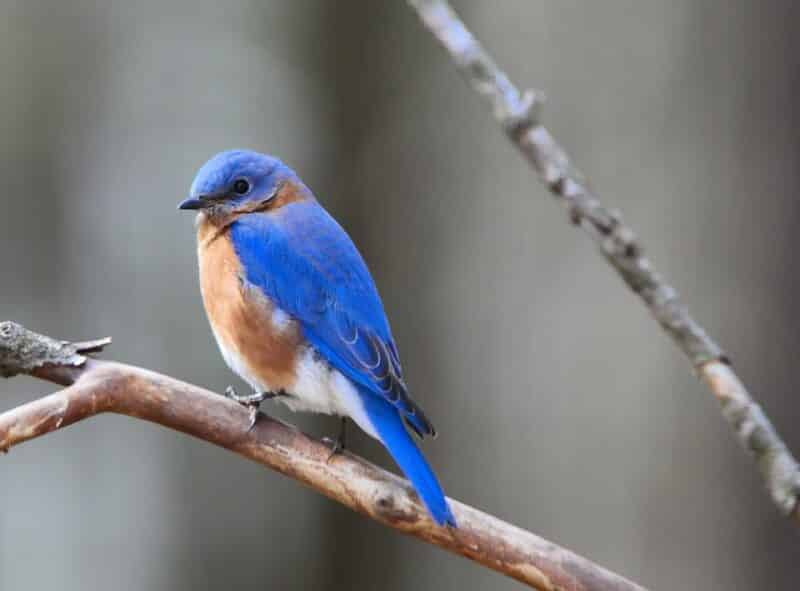
There was a time when the numbers of the exquisite eastern bluebirds were declining as their habitat and nesting sites were lost. Fortunately, their numbers have increased again. He flutters down from branches to the ground to catch insects.
But it will also hover and grab something to eat before it lands. It also feeds on berries and insects such as grasshoppers, crickets, beetles, spiders, and earthworms. Their nests are usually about 20 feet off the ground and comprise twigs, weeds, and dry grass. The bird has a round belly, short legs, long wings, and a short, straight black bill.
They are primarily identified by their bright blue heads and their wings being bright blue. The throats are rust-colored, and both males and females have white stomachs. Their predators are snakes, black bears, cats, raccoons, and Eastern chipmunks.
They are super skilled fliers and have excellent vision, noticing an insect on the ground from a distance of 60 feet! They sing to stay in touch with other members of the flock. Can you believe that they also lay eggs that are pale blue?
Horseshoe Crab

Delaware’s state marine animal is the horseshoe crab. But it looks more like a prehistoric creature that existed along with the dinosaurs! It’s strange to think they are related to scorpions and spiders.
They have a hard exoskeleton and ten legs to stand their ground on the ocean floor. Its body has three sections; the first is the head which looks like a horseshoe.
The head is the most significant part of its body and contains most of the nervous and biological organs. Its head has the heart, mouth, glands, brain, and nervous system, all protected by a large plate that protects the eyes. Around the crab are nine eyes and other light receptors near the tail. The two most enormous eyes search for mates.
The middle part of the body is the abdomen, which is shaped like a triangle. It has spines on the side with a ridge in the center. The spines can move and protect the crab and have gills for breathing. The third section is the tail, called the telson.
It is long, pointed, and looks like a weapon, although it is not dangerous or poisonous. But they use it to flip themselves over again if they land on their backs. They grow about 15 inches long and lay their eggs on the beaches in late summer and spring.
Many shorebirds, turtles, and fish look for crab eggs and eat them as an essential part of their diet. The crab’s diet consists of worms and clams, and they also eat algae. Because this crab doesn’t have teeth, it crushes the food between its legs before it brings it to its mouth.
It can live for over 20 years. Threats to them are habitat loss and overharvesting. The horseshoe crabs gather in their thousands on Delaware Bay to breed when it is a full moon, new moon, or high tides.
Grey Fox

The grey fox became the official state icon animal in Delaware in 2010. This cute little animal is a mammal and ranges through many of the states of North America, particularly the southern side. It is a peppery-grey color on the top of his body and is reddish-brown on the sides and chest.
Its legs and feet are also reddish. It has a bushy tail with a black stripe on top. Its ears are pointed ears, and it has a pointed muzzle and long hooked claws.
It often forages for food by climbing trees and even has been seen to rest in a tree. It makes its den in caves, rocky crevices, trees, and hollow logs. Sometimes if it finds a woodchuck burrow, it will use it as its den.
They usually use the den only during the mating season and raising their young. Its most important habitat is a wooded area or brush.
The fox is a solitary hunter and eats various foods, such as mice, wolves, small mammals, and eastern cottontail rabbits. It will also eat insects, plants, corn, grass, and berries. When they find crickets and grasshoppers, they will also eat them.
American Kestrel

It’s the smallest falcon in North America; the American kestrel is just 12 inches long. It has a rust-colored tail. Two vertical black stripes are on its face, and its bill is hooked. It has white cheeks, long pointed wings, with white cheeks.
The male’s wings are slate-grey, and h, ave a spotted belly and breasts. The female’s wings are rusty and h, have streaks on her breast. This bird enjoys a meal of crickets, grasshoppers, butterflies, and other insects.
It also eats small mammals, other small birds, amphibians, and reptiles. It will hover over its prey and then make a pounce. You will find this incredible bird in almost any habitat, with open areas to hunt in and tall places to perch.
It’s the only North American falcon or hawk that nests in cavities, which it makes in trees, woodpecker holes, under eaves, and nesting boxes. They often hunt in family groups, allowing the young to try their hunting skills.
If you find yourself along a roadside or in wide, open spaces, look out for this small colorful bird, usually perched on power lines. As winter sets in, they start heading for warmer climates. Apart from their beautiful looks, they are excellent fliers and astound with their incredible aerobatic abilities.
They often help to keep agricultural fields free of pests that damage crops, so farmers enjoy having them around. They usually capture their prey on the ground, although they have been seen taking game in the air. American Kestrels are solitary birds, spending most of their time alone, except in the breeding season.
American Mink

The American mink is a member of the weasel family and has a body similar to the weasel. In the past, they were harvested for their fur, which is of beautiful quality and color, always thick, glossy, waterproof, and oily.
You won’t find the American mink living in dry areas, and he is located near streams, swamps, lakes, rivers, marshes, and the coastline.
Mink habitats will be mainly dense vegetation, providing plenty of cover. They are solitary animals, and the males, mainly, are intolerant of each other. They are nocturnal and primarily active at night, mainly near dawn and dusk.
They are excellent climbers and swimmers. They can dive deep as much as 100 feet when looking for food.
They will dig burrows in lakes, streams, and riverbanks or use old dens where other mammals have lived, such as muskrats. Being carnivores, their diet will change with the season, but in summer, they love tiny frogs and crayfish, rabbits, shrews, mice, and muskrats.
They will sometimes even eat duck and other water birds and fish. They have outstanding vision, smell, and hearing skills. They kill snakes, but they don’t eat them.
Sei Whale

When we talk about whales, the sei whale is one of the fastest. It’s a solitary carnivore, feeding on krill, small fish, squid, and copepods. Its most distinctive feature is the tall, sickle-shaped dorsal fin, and it’s white or light grey. It has other names, too, such as Japan Finner, Lesser Fin Whale, Pollock Whale, Coalfish, Sardine Whale, and Rudolph’s Rorqual. It can swim at 32 mph and has a fantastic lifespan of around 70 years.
Can you believe it weighs around 31 tons with a length of 64 feet? It’s terrible to think that this magnificent creature was once part of just a handful left in the world. Thank goodness it has made a comeback, yet it is still considered endangered.
Sometimes it is hard to tell this whale apart from the fin whale. It seems strange that even though it is one of the largest animals, its diet consists of some of the most miniature ocean meals. It eats while it is on its side, with its mouth open. When it closes its mouth, it uses its tongue to push seawater out, leaving the food behind, which it gulps. They need about 2000 pounds of food each day.
This whale is a baleen whale, meaning it has baleen plates in its mouth. It strains its food from the water. Even though this species is found in most oceans and seas of the world, it avoids partially closed water, such as the Mediterranean Sea or the Gulf of Mexico.
It’s sad to think that the only predators of the sei whales, as scientists have discovered, are humans – unbelievable that between the 19th and 20th Centuries, a quarter of a million of these was killed. And yet they are so crucial to the ecosystem too. For example, they eat krill and other small marine that would imbalance the ecosystem if their populations exploded.
Cougar
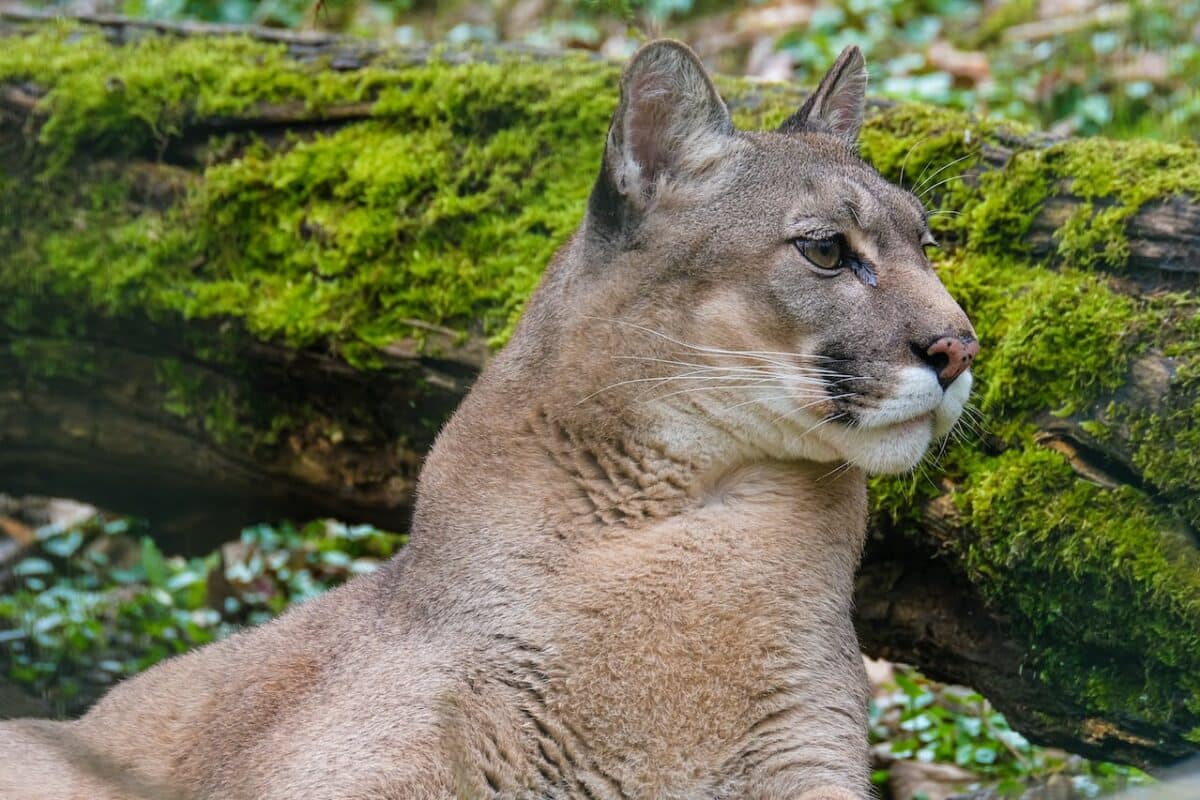
The cougar is often called the puma, maybe even a mountain lion or a panther. But it’s none of those – it’s the second-largest cat in North America. It might be significant, but it doesn’t roar like a lion – instead, it purrs similar to a house cat.
Even their bodies are like the house cat. They can weigh up to 100 pounds. They have a greyish-tan coloring and lighter underneath. The tail end has a black spot and is at home in the mountains to the deserts.
As long as they have shelter and prey, they are fine. They like to prey on deer but will also prey on smaller animals and are known to eat insects.
They will stay hidden from their prey, pouncing on it with their claws outstretched. They are excellent jumpers and can clear heights of about 20 feet. They don’t have any predators, but they compete with bears and wolves for food.
These animals in Delaware are solitary creatures, only interacting with females to mate and living to be around ten years of age.
Eastern Copperhead
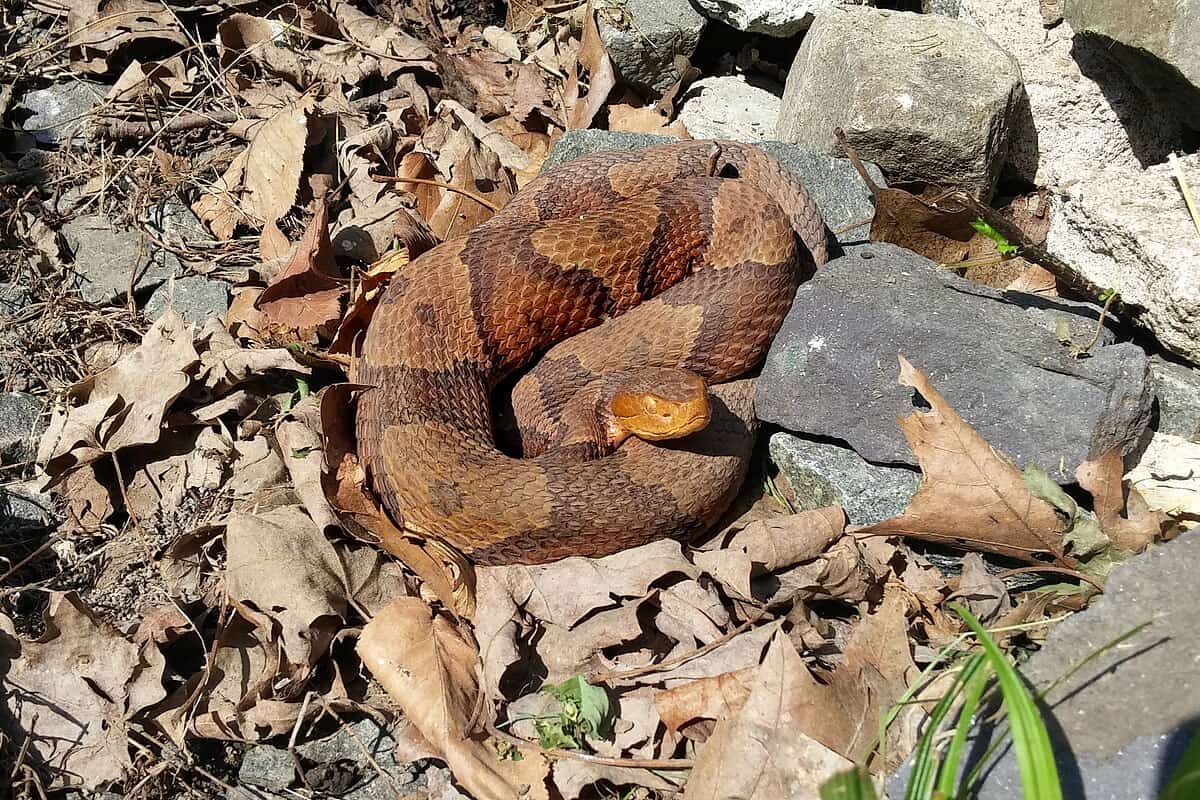
One venomous snake found in Delaware is the Eastern Copperhead. They are easy to identify, with their copper-colored head and cat cat-like vertical pupils. It’s the only snake species in Delaware with dark hourglass-shaped cross-bands, which become wider at the stomach area. They use their venom to catch prey and defend themselves.
They are also semi-aquatic. They grow to about 48 inches long. They are found near freshwater habitats, particularly cypress swamps, flood plains, rivers, and heavily vegetated wetlands. You might see them gather around drying pools in wetlands, waiting to feed on amphibians and trapped fish.
They are found during the night and day but primarily forage at night. During the day, they bask on rocks and logs near the water’s edge. They sell and they high trees.
They eat amphibians, lizards, snakes, tiny turtles, baby alligators, mammals, birds, and especially fish. When they swim, they can be easily recognized because most of their body is above the water’s surface.
A bite from one of these animals in Delaware can cause severe tissue damage around the bite area, but a bit is rare. They spend the winter in communal dens, which they seem to find each year, often joined by other snake species.
Summary of Animals and Wildlife in Delaware
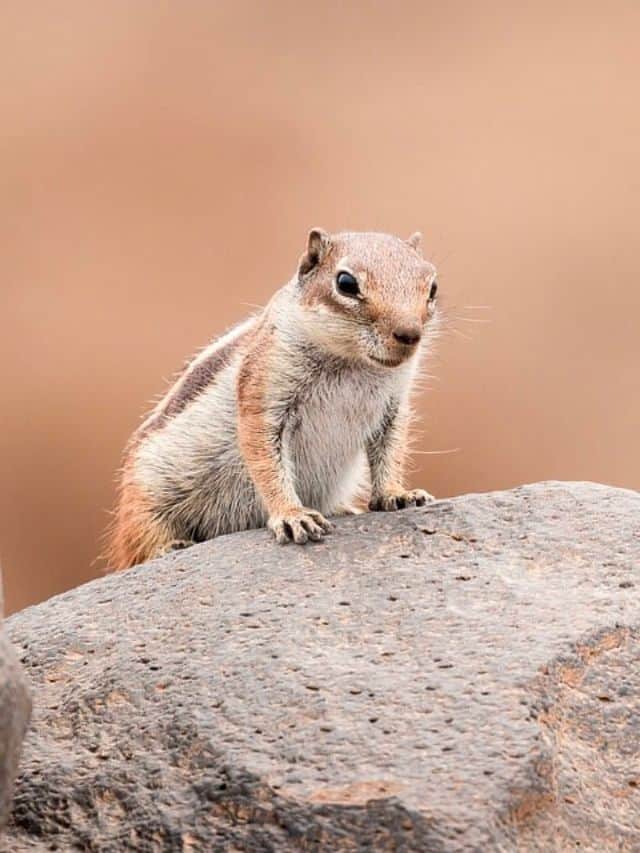
Like most of the United States of America, Delaware is a haven for animal lovers. A country is rich and a stomping ground for many different animals.
If you enjoyed reading about the animals in Delaware, check out animals in the Bahamas and Antarctica next! Also, check out Wildlife in California or Wildlife In New York.
Join our Forum for free today!

- These are The 5 Largest Great White Sharks Ever Recorded - July 19, 2024
- The Surprising Benefits of Big Game Hunting - July 18, 2024
- $100k+ Hunting Experiences The Most Expensive Animals to Pursue - July 17, 2024

